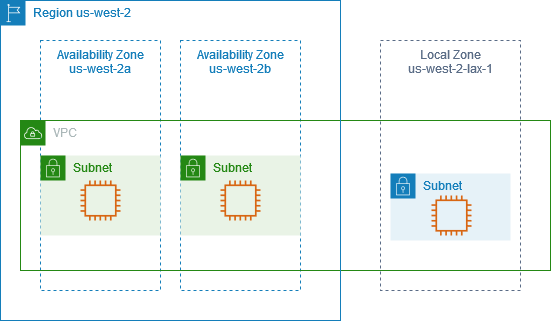Die vorliegende Übersetzung wurde maschinell erstellt. Im Falle eines Konflikts oder eines Widerspruchs zwischen dieser übersetzten Fassung und der englischen Fassung (einschließlich infolge von Verzögerungen bei der Übersetzung) ist die englische Fassung maßgeblich.
So funktionieren AWS Local Zones
Eine lokale Zone ist eine Erweiterung einer AWS Region in geografischer Nähe zu Ihren Benutzern. Local Zones verfügen über eigene Verbindungen zum Internet und Support AWS Direct Connect, sodass Ressourcen, die in einer lokalen Zone erstellt wurden, Anwendungen bedienen können, die eine geringe Latenz erfordern.
Um eine Local Zone verwenden zu können, müssen Sie diese zunächst aktivieren. Als Nächstes erstellen Sie ein Subnetz in der lokalen Zone. Schließlich starten Sie Ressourcen im Subnetz der lokalen Zone. Weitere detaillierte Anweisungen finden Sie unter Erste Schritte mit AWS Local Zones.
Das folgende Diagramm zeigt ein Konto mit einer VPC in der AWS Regionus-west-2, die auf die lokale Zone us-west-2-lax-1 ausgedehnt ist. Jede Zone in der VPC hat ein Subnetz, und jedes Subnetz hat eine Instanz. EC2

AWS in Local Zones unterstützte Ressourcen
Wenn Sie eine Ressource in einem Subnetz der lokalen Zone erstellen, ist sie in der Nähe Ihrer Benutzer. Eine Liste der Dienste mit Ressourcen, die in lokalen Zonen unterstützt werden, finden Sie unter Funktionen für AWS Local Zones
Überlegungen
-
Subnetze der lokalen Zone folgen denselben Routing-Regeln wie Availability Zone-Subnetze, einschließlich der Verwendung von Routing-Tabellen, Sicherheitsgruppen und Netzwerken. ACLs
-
Der ausgehende Internetverkehr verlässt eine lokale Zone aus der lokalen Zone.
-
AWS-Region Beim Herstellen einer Verbindung von einem Standort vor Ort mit einer lokalen Zone über ein Transit Gateway wird der Netzwerkverkehr bis zum
-
Sie können beim Erstellen eines Cloud-WAN- oder Transit-Gateway-VPC-Anhangs kein Subnetz aus einer lokalen Zone auswählen. Dies führt zu einem Fehler.
-
Datenverkehr, der für ein Subnetz in einer lokalen Zone bestimmt ist, AWS Direct Connect wird nicht durch die übergeordnete Region der lokalen Zone geleitet. Stattdessen nimmt der Verkehr den kürzesten Weg zur lokalen Zone. Dies verringert die Latenz und trägt dazu bei, dass Ihre Anwendungen schneller reagieren.
Wenn Sie eine stabilere Verbindung benötigen, implementieren Sie mehrere Verbindungen AWS Direct Connect zwischen Ihren lokalen Standorten und der lokalen Zone. Weitere Informationen zum Aufbau von Resilienz mit AWS Direct Connect finden Sie unter AWS Direct Connect Resilienz-Empfehlungen
. -
Die folgenden Local Zones unterstützen IPv6:
us-east-1-atl-2aus-east-1-chi-2a,us-east-1-dfw-2a,us-east-1-iah-2a,us-east-1-mia-2a,us-east-1-nyc-2a,us-west-2-lax-1a,us-west-2-lax-1b, undus-west-2-phx-2a. -
Die folgenden Local Zones unterstützen die Edge-Verknüpfung mit Virtual Private Gateway (VGW):
us-east-1-atl-2a,us-east-1-chi-2a,us-east-1-dfw-2a,us-east-1-iah-2a,us-east-1-mia-2a,,us-east-1-nyc-2aus-west-2-lax-1aus-west-2-lax-1b, und.us-west-2-phx-2aInformationen zur Edge-Assoziation und zu anderen Route-Tabellenkonzepten finden Sie unter Konzepte für Routing-Tabellen im Amazon VPC-Benutzerhandbuch.
Informationen zu Virtual Private Gateway und anderen AWS Site-to-Site VPN Konzepten finden Sie unter Konzepte im AWS Site-to-Site VPN Benutzerhandbuch.
-
Sie können keine VPC-Endpunkte in Subnetzen der lokalen Zone erstellen.
-
Das AWS Site-to-Site VPN ist in Local Zones nicht verfügbar. Verwenden Sie ein softwarebasiertes VPN, um eine site-to-site VPN-Verbindung zu einer lokalen Zone herzustellen.
-
Im Allgemeinen lautet die maximale Übertragungseinheit (MTU) wie folgt:
-
9001 Byte zwischen EC2 Amazon-Instances in derselben lokalen Zone.
-
1500 Byte zwischen einem Internet-Gateway und einer lokalen Zone.
-
1468 Byte zwischen AWS Direct Connect und einer lokalen Zone.
-
1300 Byte zwischen einer EC2 Amazon-Instance in einer Local Zone und einer EC2 Amazon-Instance in der Region für die meisten Local Zones außer:
-
9001 Byte für
us-west-2-lax-1aundus-west-2-lax-1b -
801 Byte für
us-east-1-atl-2a,us-east-1-chi-2a,us-east-1-dfw-2aus-east-1-iah-2a,us-east-1-mia-2aus-east-1-nyc-2a, undus-west-2-phx-2a
-
-
Ressourcen
Erfahren Sie anhand der folgenden Ressourcen, wie Sie mit AWS Local Zones beginnen können: